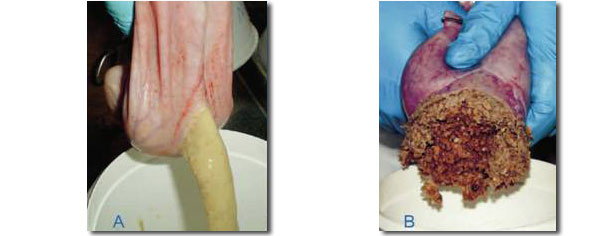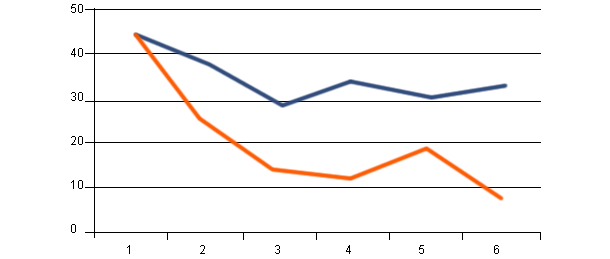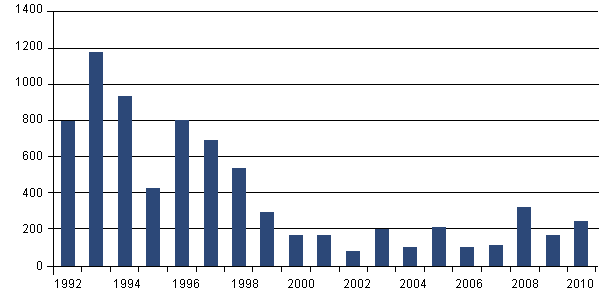Background
The Danish Salmonella control program started in 1995. Since then an extensive research effort has resulted in an in-depth knowledge of risk factors for Salmonella in Danish pig herds and development of a series of intervention factors. Especially it has been realised that there are a set of risk factors related to the introduction of Salmonella into pig herds, and another set of risk factors can influence whether the infected herd will have a high prevalence or a medium to low prevalence.

But even a relatively low level in primary production can result in a high number of contaminated carcasses at the slaughterhouse-level, if slaughter hygiene is suboptimal. And even relatively high levels in primary production can result in a low number of positive carcasses, if slaughter house hygiene is optimal.
Finally decontamination of carcasses by hot water, steam, or other physical or chemical methods can in the future contribute significantly to the reduction of contaminated carcasses, and a reduction of human cases.
In this paper focus will be on interventions in primary production, although interventions on slaughterhouses are in many cases very effective.
Risk factors for introduction of salmonella into pig herds
In the Danish pig production Salmonella Typhimurium and Salmonella Derby are by far the most important sero-types. Salmonella can be introduced into pig herds in numerous ways: Feed, rodents, birds, persons. But Danish research has shown that the introduction of growers from salmonella-positive sow herds is the main risk factor for introducing the most important serotypes into slaughter pig herds.
And buying replacement gilts from Salmonella-positive breeder and multiplier herds are the main risk factor for getting infected with Salmonella Typhimurium and Salmonella Derby.
Feed can introduce Salmonella into pig herds, but in most countries, the serotypes found in feed are of lesser importance. In many cases these serotypes will disappear from the herd without any intervention. And furthermore these serotypes are often of limited zoonotic importance.
Risk factors for high salmonella prevalence in pig herds
Feed, management and hygiene have been identified as the most important risk factors for high salmonella prevalence in positive herds.
Half the Danish pig herds use pelleted, heat treated feed, and the other half mix the feed on the farm, using non-heat-treated ingredients. It was generally believed, that the use of home-mixed non-heat-treated feed would be a risk factor, but epidemiological research showed that herds using pelleted feed on average had 3 times more salmonella than herds using home-mixed feed.
Clinical trials and laboratory experiments confirmed the results, and further research showed that the use of home-mixed, non-pelleted, non-heat treated feed resulted in a microbiological flora of the gut, that would reduce the ability of Salmonella to colonise the gut.
Pigs fed non-heat treated feed had more lactobacilli, a higher level of organic acids, and fewer coli-forms in the gut. The physical structure of the content of the ventricle is more solid when using home-mixed feed, compared to pelleted feed, where the content is very liquid. (See figure 1). The result is that this type of feeding can control but not eradicate salmonella in the herd.
Herds using liquid feed systems have a lower level compared to dry feed systems. Natural fermentation often reduces pH in the feed to below 4.5 in these systems.

The mechanism behind this is probably related to the effect of home-mixed feed: Increase in lactobacilli, higher level of organic acids and lower level of coliforms. Epidemiological research showed that herds using liquid, home-mixed feed had the lowest prevalence, herds using liquid, pelleted feed or dry, home-mixed feed had on average 3 times higher prevalences, whereas herds using dry, pelleted feed on average had 9 times higher prevalence than herds using liquid, home-mixed feed.

Figure 1. The pig to the left was fed pelleted feed, the pig to the right was fed home-mixed feed. The content of the ventricle to the left is fluid, the gut content will have fewer lactobacilli, lower level of organic acids, and more coliform, compared to the pig fed home-mix (photo courtesy of Fink-Hansen, Danish Pig Research Centre).
Low hygiene and continuous flow management can increase the salmonella level in positive herds. Improved hygiene and change of pig flow into all in-all out on room level can reduce the level, although the results are somewhat unreliable. In general it is recommended to combine change of management with feed interventions.
Intervention plans in high prevalence herds
High prevalence herds can reduce the level by a combination of feed related interventions and improved management and hygiene.
Organic acids in water or feed have been shown to reduce the prevalence in high prevalence herds.
Change into home-mixing, or the addition of non-heat treated barley and wheat to pelleted feed has been successfully used as interventions. Exchanging wheat with higher levels of barley in the diet also reduced the salmonella prevalence.
Improved hygiene and change of management into all-in all out pig flow have contributed to good results in many herds.
Unfortunately most herds that become infected with Salmonella Derby and Salmonella Typhimurium will continue to be infected. Interventions can only reduce but not eradicate salmonella from the herd. This emphasises the importance of trying to avoid introduction especially Salmonella Typhimurium or Salmonella Derby.

Figure 2. Reduction in average percent salmonella-positive pigs 6 months after introduction of feed with non-heat treated barley or wheat in 30 high prevalence trial herds, compared to sero-prevalence in 30 high prevalence control herds without this type of feed. After 6 months trial herds were below 10 %, and control herds above 30.
Number of human cases attributed to Danish pork

Year
Figure 3. Number of human cases attributed to pork. Since 1993 the number of human cases has dropped 80 %. Two outbreaks in 2008 and one in 2010 with a relatively large number of cases were caused by smaller slaughterhouses. In all three cases it was found that a combination of suboptimal hygiene and the slaughter of incorrectly classified herds contributed to the outbreaks.


